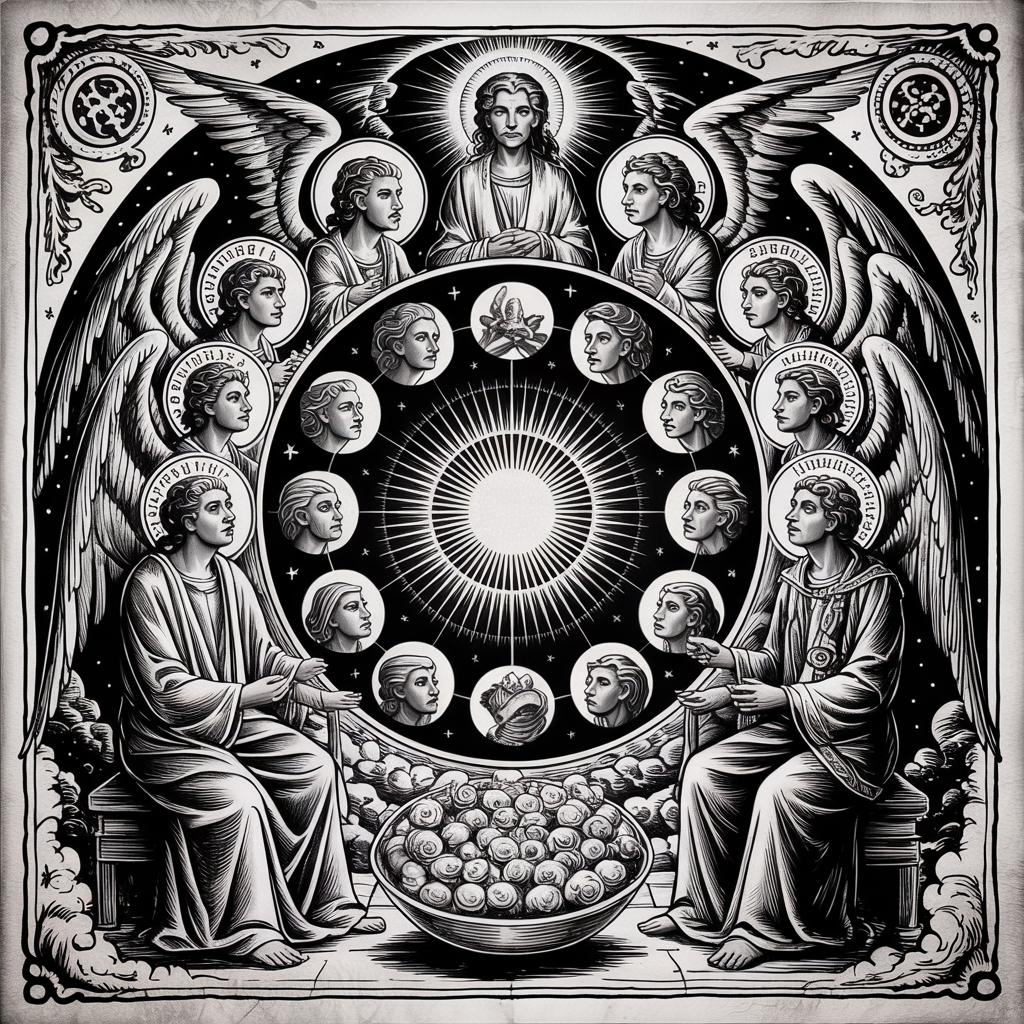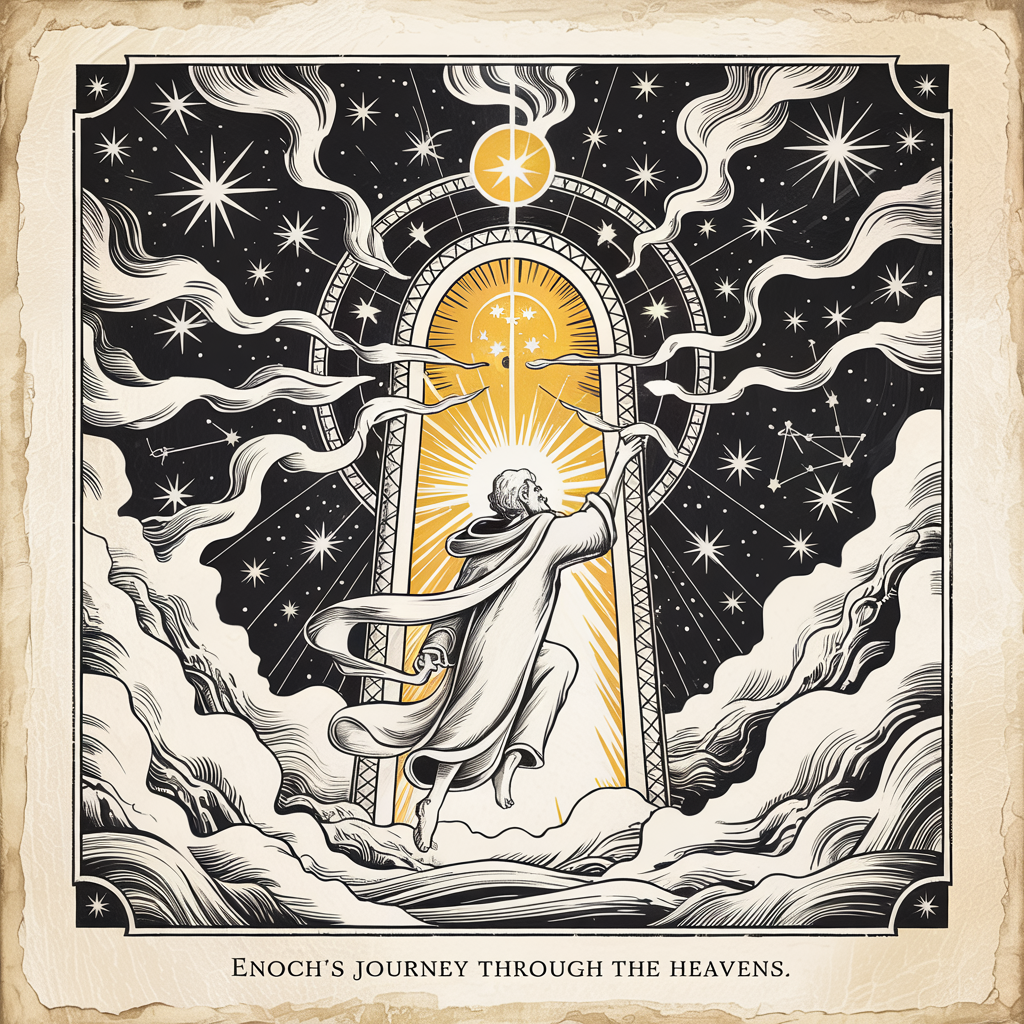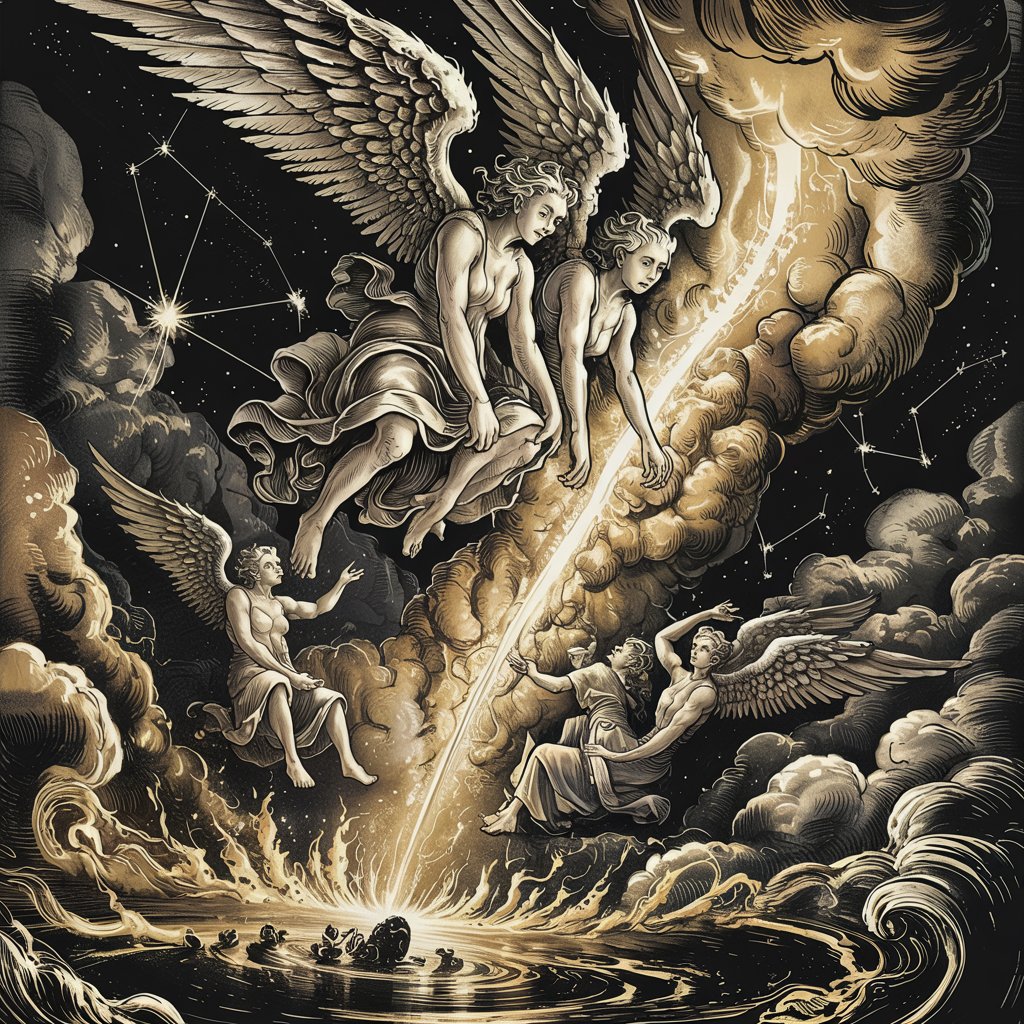Divine Hierarchies and the Nine Orders of Angels: What Ancient Texts Reveal

Modern depictions of angels often reduce them to kind-hearted guardians with feathered wings. But ancient texts paint a much more awe-inspiring and structured picture—one where angels exist in a complex hierarchy, each with specific roles, ranks, and divine duties. The Book of Enoch is one of the earliest sources that details these celestial orders, describing a universe governed by spiritual intelligence far beyond our own. From the fiery seraphim to the mysterious archangels, this divine structure reveals how heaven itself is organized. The Nine Orders of Angels: A Cosmic Chain of Command Later Christian mystics like Pseudo-Dionysius categorized angels into nine choirs, grouped in three triads. While this system is later than Enoch, the seeds of this hierarchy are already present in Jewish apocalyptic texts. Here’s a quick overview of the traditional angelic orders: Seraphim – Closest to God, beings of pure fire and love Cherubim – Guardians of divine knowledge and cosmic secrets Thrones – Bearers of God’s justice and authority Dominions – Regulators of angelic duties Virtues – Carriers of divine grace and miracles Powers – Warriors against evil and cosmic disorder Principalities – Overseers of nations and earthly realms Archangels – Messengers of great importance (Michael, Gabriel, Raphael…) Angels – Closest to humanity, including guardian angels The Book of Enoch, particularly in its later mystical expansions (like 3 Enoch), aligns with this view—especially through its exaltation of Metatron, the transformed Enoch who becomes the “Prince of the Presence.” Metatron: The Human Who Became Divine One of the most intriguing figures in angelology is Metatron, who begins his journey as Enoch the man, but through divine favor and spiritual transformation, becomes the highest of angels. Metatron acts as a heavenly scribe, recording the deeds of humanity and acting as an intermediary between God and creation. In many traditions, he is so powerful that no other angel may speak directly with the Divine without going through him. His role demonstrates that in this spiritual hierarchy, divine closeness is not static—it can be earned through righteousness, wisdom, and divine mission. Angelic Purpose and Cosmic Order Each angelic order serves a unique function in the divine ecosystem. They are not abstract symbols; they are beings of intention and action, responsible for: Upholding divine law Executing justice Guiding creation toward order and harmony Transmitting spiritual energy across realms This structured approach reflects a cosmos of sacred design—not chaos. Just as the stars move in ordained paths, so too do the angels move according to divine will. Why This Hierarchy Still Matters In a world often overwhelmed by disorder, the angelic hierarchy reminds us of a higher order at work. It suggests that: There is meaning behind the unseen. There are layers to the spiritual world. And that divine intelligence operates far beyond our comprehension. For mystics, seekers, and those drawn to the mysteries of the unseen, the study of angels is not just theological—it’s transformative. If the structure of the heavens intrigues you, the Book of Enoch offers an even deeper look into angelic orders, cosmic realms, and divine communication. Get your copy of The Book of Enoch by Rush Nilson → and explore the celestial system beyond imagination.
How the Book of Enoch Influenced Early Christianity and Apocalyptic Thought

The Book of Enoch is one of the most mysterious and influential ancient texts that never made it into most versions of the Bible. Yet, its fingerprints are everywhere—from Jewish apocalyptic writings to the very pages of the New Testament. In fact, early Christians knew Enoch well. They quoted it. They echoed it. And in some ways, they built their apocalyptic worldview around it. How could a book deemed “non-canonical” have such a lasting impact? The answer lies in its theological depth, visionary power, and the way it bridges Earth and Heaven, past and future. Enoch and the Apocalyptic Imagination The apocalyptic themes of judgment, resurrection, and the end of days were not invented by early Christians—they were inherited. And one of their primary sources was the Book of Enoch. Written during the Second Temple period, Enoch was widely read among Jewish sects, including the Essenes (who preserved portions of the book among the Dead Sea Scrolls). Its cosmic battles, angelic hierarchies, and final judgments laid the groundwork for what would become Christian eschatology. The idea of history moving toward a climactic divine judgment—so central to Christianity—owes much to Enoch. The Son of Man: Enoch’s Messianic Vision One of the most striking elements of 1 Enoch is the portrayal of a Messianic figure called the “Son of Man”—a heavenly being, seated beside God, who will judge the wicked and reign in glory. Sound familiar? This figure prefigures how Jesus is described in the Gospels, particularly in the books of Matthew and Revelation. Even the Book of Daniel echoes this imagery, but Enoch expands on it in profound detail. “And there I saw One who had a head of days… And with Him was another being whose countenance had the appearance of a man…” — 1 Enoch 46 This passage shaped how early Christians envisioned Christ’s divine role, especially in apocalyptic contexts. Direct Citations: The Epistle of Jude The Epistle of Jude in the New Testament doesn’t just resemble Enoch—it quotes it directly: “Behold, the Lord comes with ten thousands of His holy ones to execute judgment…” — Jude 14-15 This is a verbatim citation from 1 Enoch 1:9. The fact that a canonical New Testament writer cites Enoch as prophecy shows just how authoritative and respected the text was in early Christian circles. Why Was It Left Out? So why didn’t Enoch make the cut into the official biblical canon? There were several reasons: theological disputes, concerns about its mystical content, and evolving church politics. However, Enoch continued to circulate, especially in Ethiopian Christianity, where it remains canonical to this day. It also survived in mystical traditions, including Kabbalah, Gnosticism, and even early Islamic interpretations. Enoch’s Enduring Legacy Far from being a forgotten text, the Book of Enoch remains one of the foundational works of apocalyptic literature. Its themes live on in: The idea of final judgment The vision of cosmic justice The depiction of heavenly intercession The destiny of the righteous and the wicked And most notably, in the image of a divine Redeemer—enthroned in heaven, returning in power. If Enoch Shaped Christianity, What Can It Still Teach Us Today? In a time when many are rediscovering lost spiritual traditions, Enoch offers a compelling voice. It challenges us to think cosmically, to imagine a universe governed by justice, and to believe that human history is part of something far larger than itself. This is more than ancient theology. It’s a vision that still speaks—to seekers, scholars, and all who long for divine clarity in chaotic times. Conclusion: If the influence of Enoch fascinates you, the full text holds even greater revelations—visions of fire, prophecy, heavenly ascent, and divine judgment. Get your copy of The Book of Enoch by Rush Nilson → and explore the roots of Christian mysticism and apocalyptic hope.
Enoch’s Journey Through the Heavens: Mystical Cosmology in Ancient Texts

Long before modern cosmology offered galaxies and black holes, ancient spiritual texts painted their own vision of the universe. Among them, the Book of Enoch stands out as a bold, mystical map of the heavens. More than a prophet, Enoch was a divine traveler, ascending through celestial realms, encountering angelic beings, and witnessing the architecture of the cosmos itself. His journey wasn’t just physical—it was spiritual, symbolic, and transformative. The Ascent Begins: Enoch’s Call to the Heavens Enoch’s journey starts with a divine invitation. In the Book of Enoch (1 Enoch), he is taken up in a vision by angels—lifted beyond Earth to a realm of crystal palaces, flaming thrones, and radiant beings. “Clouds invited me, a mist summoned me… the winds lifted me upward and bore me into heaven.” — 1 Enoch 14:8 As he ascends, Enoch moves through increasingly sacred levels of heaven, each with its own purpose and order. He observes the movement of stars, gateways of the winds, and divine halls where angels sing and judge. Celestial Geography: The Structure of the Heavens One of the most fascinating elements of Enoch’s journey is his description of cosmic structure. Unlike flat-earth or chaotic cosmologies of the time, Enoch presents a vision of: Multiple heavens, layered like dimensions; Treasuries of wind, rain, snow, and fire, each guarded by angels; Portals for the sun and moon, dictating their seasonal paths; Mountains of metal and fire, representing divine judgment and mystery. This vision reflects an ancient belief in ordered, intelligent design—a universe run not by chance, but by spiritual law and angelic function. Angelic Realms and Hierarchies As Enoch rises, he encounters powerful beings: seraphim, cherubim, ophanim, and archangels. Each order of angels holds distinct roles: Michael – protector of the righteous; Raphael – healer of Earth and spirit; Gabriel – messenger and warrior; Uriel – keeper of cosmic knowledge. At the highest level, Enoch sees the Throne of Glory, surrounded by fire and light. Here sits the Ancient of Days, unapproachable by any mortal. This vision later influenced Jewish Merkabah mysticism and Kabbalah, forming the foundation of esoteric traditions still studied today. Transformation: Enoch Becomes Metatron In later texts like 3 Enoch, the journey continues beyond simple observation—Enoch is transformed. No longer just a man, he becomes Metatron, the “Prince of the Presence,” and chief among angels. This transformation represents the mystical ideal of divine union—a human soul so pure it is elevated to stand at the very side of God. It’s a powerful image of spiritual evolution, emphasizing: Purity, Obedience and Mystical insight Why Enoch’s Journey Still Matters Today, Enoch’s ascent resonates with anyone exploring: Spiritual transformation The structure of the soul and universe The connection between science, spirituality, and mystery His journey invites us to ask: What lies beyond the visible? What hidden structures guide the universe? And how can a human being rise into the divine? Conclusion: Mapping the Invisible Enoch’s heavenly journey is more than myth—it’s a spiritual roadmap. In a world hungry for meaning, his story offers a vision of harmony, order, and transcendent purpose. He invites us to look up—not just into the sky, but into the higher truths that lie beyond it. If Enoch’s heavenly journey sparked something in you, the Book of Enoch offers much more—detailing visions of celestial architecture, angelic realms, and the divine laws that shape creation itself.Get your copy of The Book of Enoch by Rush Nilson → and begin your own ascent through the mysteries of the universe.
The Watchers and the Origins of Evil: Exploring the Mythic Fall of the Angels

Tucked away in the shadows of biblical history lies one of the most dramatic and enigmatic tales ever told. While the canonical Bible briefly mentions the “sons of God” and the “giants on the Earth,” the Book of Enoch offers a full, vivid narrative: the tragic saga of the Watchers, the angels who fell from grace. Far from being a simple story of divine punishment, this is a myth about knowledge, power, and the catastrophic consequences of breaking cosmic boundaries. It’s a story that echoes through time and continues to captivate readers, scholars, and seekers of esoteric wisdom. Who Were the Watchers? The Watchers were a group of 200 angels sent to Earth by God to observe and guide humanity. But their mission was quickly compromised. As described in 1 Enoch Chapters 6–8, these celestial beings became infatuated with human women. Led by the angel Semjaza, they conspired to take wives and bear children with them—an act that defied divine law. To ensure solidarity, the Watchers bound themselves by oath, knowing their actions would bring heavenly wrath. This was not merely lust—it was a deliberate rebellion against the divine order. Their offspring? Beings of terrible might. The Nephilim: Hybrid Giants Born of Heaven and Earth The union of angels and humans produced the Nephilim, often translated as “giants.” These weren’t merely tall or strong beings—they were mythic hybrids, unnatural in both form and spirit. According to the text, they ravaged the Earth, consuming its resources and spreading violence. “And they became pregnant, and they bore great giants… who consumed all the acquisitions of men… and began to sin against birds, and beasts, and reptiles, and fish, and devoured mankind.” — 1 Enoch 7 As their hunger grew, so did their spiritual corruption. Their very existence was a distortion of divine design—proof that what begins as temptation can end in ruin, not just for the individual, but for the world. The Spread of Forbidden Knowledge One of the most powerful elements of this story is the dissemination of forbidden knowledge. The Watchers, in their defiance, began to teach humanity secrets meant only for heaven: Azazel taught warfare, metallurgy, and cosmetics—tools of destruction and vanity. Semjaza taught enchantments and root-cutting. Others revealed astrology, the movements of celestial bodies, and esoteric sciences. This echoes the Promethean myth in Greek lore—the idea that stolen wisdom leads not to enlightenment, but to downfall. In Enoch’s account, knowledge without spiritual maturity becomes a weapon, not a gift. Divine Judgment and the Flood As chaos spread, the archangels—Michael, Uriel, Raphael, and Gabriel—intervened, bringing their pleas before God. The verdict was swift and uncompromising. Azazel was cast into a desolate abyss, bound and blinded. The Watchers were imprisoned until the Day of Judgment, unable to return to heaven. The Nephilim were wiped out in a divine flood—a judgment that foreshadows the story of Noah. Enoch served as a scribe and prophet in this saga, acting as an intermediary between heaven and Earth. He warned the Watchers of their fate and documented the unraveling of the cosmic order. Symbolism and Spiritual Implications Beyond the narrative, the fall of the Watchers represents a universal spiritual truth: that transgression, especially by those in positions of power or knowledge, has ripple effects that extend far beyond the self. The Watchers’ story forces us to ask: What happens when wisdom is separated from morality? Can power exist without corruption? Is rebellion ever justified, even in the pursuit of beauty or love? In this context, the Book of Enoch becomes more than a myth—it’s a mirror reflecting the dangers of unchecked desire, hubris, and misplaced trust in human (or angelic) will. Influence on Religious and Popular Thought Though excluded from most biblical canons, 1 Enoch was highly influential in Second Temple Judaism and the early Christian era. The Epistle of Jude (Jude 14–15) directly quotes Enoch, highlighting its importance to early believers. The Watchers also inspired elements in: Christian demonology Islamic traditions of jinn and fallen angels Modern literature and cinema, from Paradise Lost to The Lord of the Rings, and even The Matrix The myth has endured because it taps into something timeless: our fascination with forbidden knowledge, divine boundaries, and the mysterious watchers who once walked among us. Conclusion: The Echoes of a Forgotten War The fall of the Watchers is not just a tale from a lost text—it’s a spiritual parable that still speaks today. It’s a warning against arrogance, a lament for what was lost, and a call to respect the balance between heaven and Earth. As we stand at the crossroads of science, spirituality, and ethics in our modern age, the story of the Watchers invites us to reflect on how we use the gifts of knowledge and power—and whether we, too, risk falling when we forget our divine place. If this story intrigued you, the full Book of Enoch goes even further—into visions of fire and stars, ancient angelic realms, and mysteries long hidden from the world. This edition brings the text to life with clarity and insight.Get your copy of The Book of Enoch by Rush Nilson → and continue the journey beyond the fall of the Watchers.

